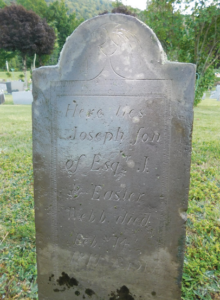Fancy D Revealed?
We spend much of our time visiting and working in cemeteries and we like to study and research the early sandstone gravestone carvers that plied their trade from about 1800-1845. » Read the rest...
This is a study of gravestone carvers. Although it focuses primarily on Central New York, we have identified carvers throughout the state. The timeframe is 1795-1880.
The winter of 2015-2016 was a mild one. With our usual seasonal cemetery work behind us, we wondered what we could do to occupy our time. Based on Nelson Tiffany’s book: Chenango County Cemeteries 1991, we decided to visit each of the county’s cemeteries which numbered about 275. Prior to this, we had knowledge of some local gravestone carvers gained from our association with our mentor Mary Dexter. We were not prepared for the discoveries we found as we walked through our local cemeteries. It appeared that Chenango County had an abundance of carvers we knew nothing about. Since then, we have been gathering information and collecting data on these carvers.
This is the first attempt, that we know of, compiling any research on the carvers of central N.Y. This is a formidable project. At first our focus was to find gravestones that were signed by the carver but those were few and far between. In the absence of a name to categorize the stones, we gave the carver a pseudonym, based on distinguishing characteristics of his carving: Curly Q, Fancy D, Circle Vine Man, Cooperstown Carver, etc.
Our hope was to find a stone that the carvers signed so that we could use that to identify his work. The next best approach is to review probate records in hopes it contains the name of who got paid for carving the gravestone. This avenue has great limitations and is time consuming. The real names of these carvers may never be known. Our goal is to bring attention to this great group of unique artisans who played a significant role in our history as their work will remain in our cemeteries for generations to come.
Here we will provide whatever written information we may have found on the carver, where their work can be found and the unique characteristics that distinguishes their work from someone else. This is a companion piece to Gravestones and Carvers of NYS, Pre -1850 which contains photographs of the carvers work represented here.
We spend much of our time visiting and working in cemeteries and we like to study and research the early sandstone gravestone carvers that plied their trade from about 1800-1845. » Read the rest...
⇨ Read all articles about cemeteries

Sponsored by the American Antiquarian Society, it contains more than 13,500 images of more than 9,000 gravestones.
